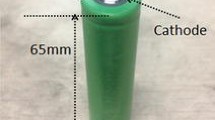Abstract
The overcharge kinetics of a commercial prismatic Li-ion battery at different current rates (1 C, 2 C, and 3 C) has been studied. Battery surface temperature, heat output, and voltage were monitored and analyzed during overcharge testing. It has been shown that the heat rate of the battery surface does not increase in proportion to the applied current rate. Separator shutdown properties may be realized for heat rates less than 3 °C/min. Li-ion batteries have been submitted to different stages of overcharge by a “soft” overcharge technique (1 C to 4.4, 4.6, and 5.0 V). Differential scanning calorimetry (DSC) tests of the charged anode, cathode, and separator recovered from overcharged cells have been performed. It was found that the anode at different overcharged states has two main exothermic peaks at 120 and 300–320 °C. At a higher state of overcharge (SOOC), the second peak shifts to a lower temperature. DSC for overcharged cathodes has more complicated profiles depending on SOOC. Increasing the cutoff voltage from 4.4 to 5.0 V shifts the maximum of the first temperature peak from 235 to 200 °C and the second from 345 to 320 °C. Electrical impedance spectroscopy and scanning electron microscopy have been used to characterize electrode materials at different SOOC and overcharge conditions. The heat rate (related to current), cell construction, and design are considered as the main factors of Li-ion battery failure at overcharge.














Similar content being viewed by others
References
Reimers JN, Dahn JR (1992) J Electrochem Soc 139:2091
Maleki H, Hallaj SA, Selman JR, Dinwiddie RB, Wang H (1999) J Electrochem Soc 146:947
Du Pasquier A, Disma F, Bowmer T, Gozdz AS, Amatucci GG, Tarascon J-M (1998) J Electrochem Soc 145:472
Maleki H, Deng G, Anani A, Howard J (1999) J Electrochem Soc 146:3224
Dahn JR, Fuller EW, Obrovac M, von Sacken U (1994) Solid State Ionics 69:12
Cho J (2004) J Power Sources 126:186
Kim J, Noh M, Cho J (2006) J Power Sources 153:345
Cho J, Kim T-G, Kim C, Lee J-G, Kim Y-W, Park B (2005) J Power Sources 146:58
Xiao L, Ai X, Cao Y, Yang H (2004) Electrochim Acta 49:4189
Moshuchak LM, Bulinski M, Lamanna WM, Wang RL, Dahn JR (2007) Electrochem Comm 7:1497
Chen G, Thomas A, Karen E, Newman J, Richardson TJ (2005) Electrochim Acta 50:4666
Underwriters Laboratories (1995) A safety standard for lithium batteries, UL 1642, 3rd edn.
Japan Battery Association (1997) Guideline for the safety evaluation of secondary lithium cells. Tokyo, Japan
Leising RA, Palazzo MJ, Takeuchi ES, Takeuchi KJ (2001) J Electrochem Soc 148:A838
Tobishima S, Yamaki J (1999) J Power Sources 81–82:882
Kumai K, Miyashiro H, Kobayashi Y, Takei K, Ishikawa RI (1999) J Power Sources 81–82:715
Aurbach D, Gamolsky K, Markovsky B, Salitra G, Gofer Y, Heider U, Oesten R, Schmidt M (2000) J Electrochem Soc 147:1322
Hjelm AK, Lindbergh G (2002) Electrochim Acta 47:1747
Aurbach D, Zaban A, Gofer Y, Ein Ely Y, Weissman I, Chusid O, Abramson O (1995) J Power Sources 54:76
Aurbach D, Ein Eli Y, Markovsky B, Zaban A, Luski S, Carmeli Y, Yamin H (1995) J Electrochem Soc 142:2882
Zhang Z, Fouchard D, Rea JR (1998) J Power Sources 70:16
Author information
Authors and Affiliations
Corresponding author
Additional information
Contribution to ICMAT 2007, Symposium K: Nanostructured and bulk materials for electrochemical power sources, July 1–6, 2007, Singapore.
Rights and permissions
About this article
Cite this article
Belov, D., Yang, MH. Failure mechanism of Li-ion battery at overcharge conditions. J Solid State Electrochem 12, 885–894 (2008). https://doi.org/10.1007/s10008-007-0449-3
Received:
Revised:
Accepted:
Published:
Issue Date:
DOI: https://doi.org/10.1007/s10008-007-0449-3




